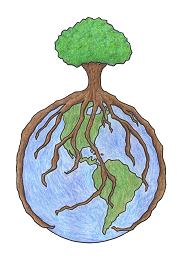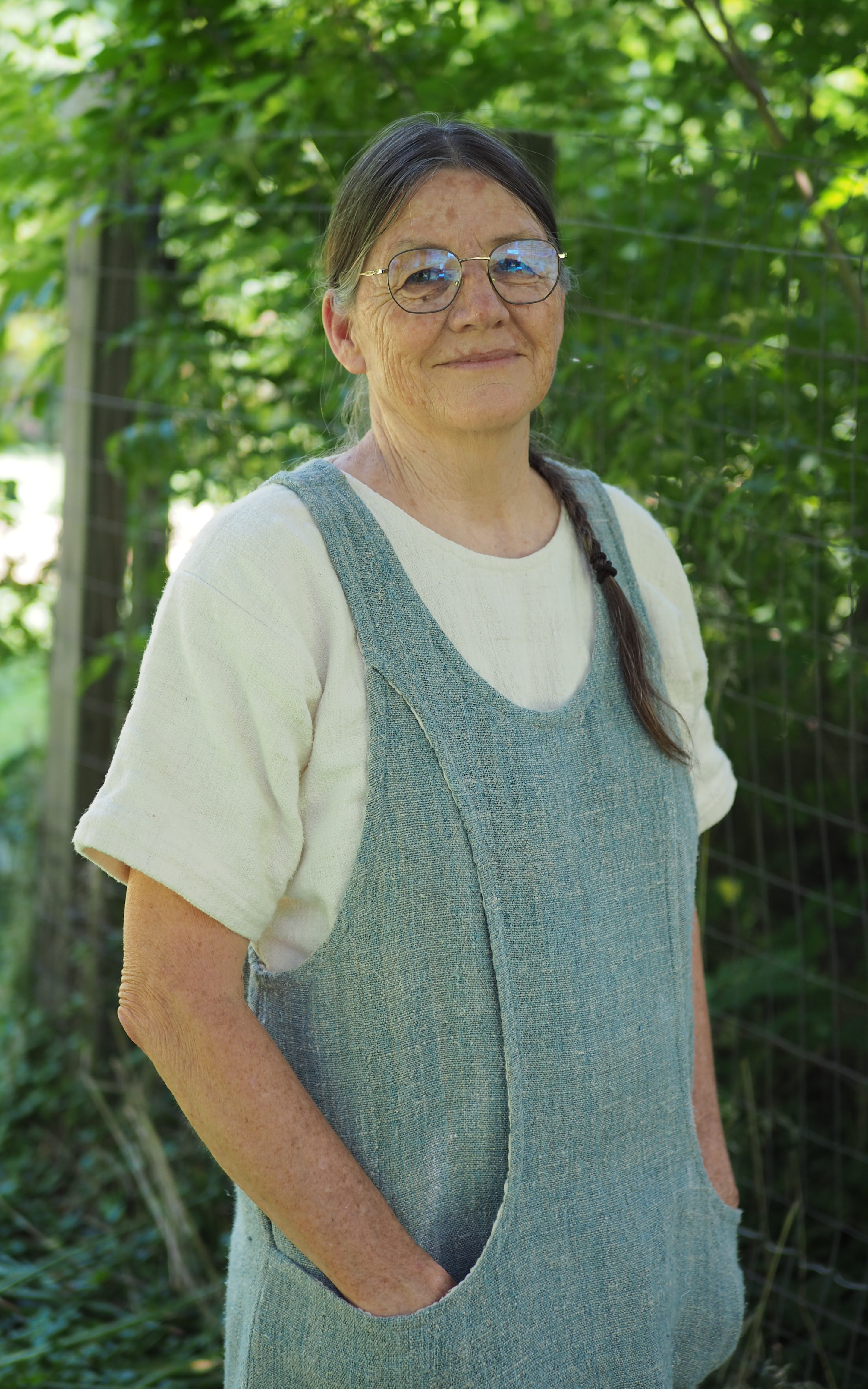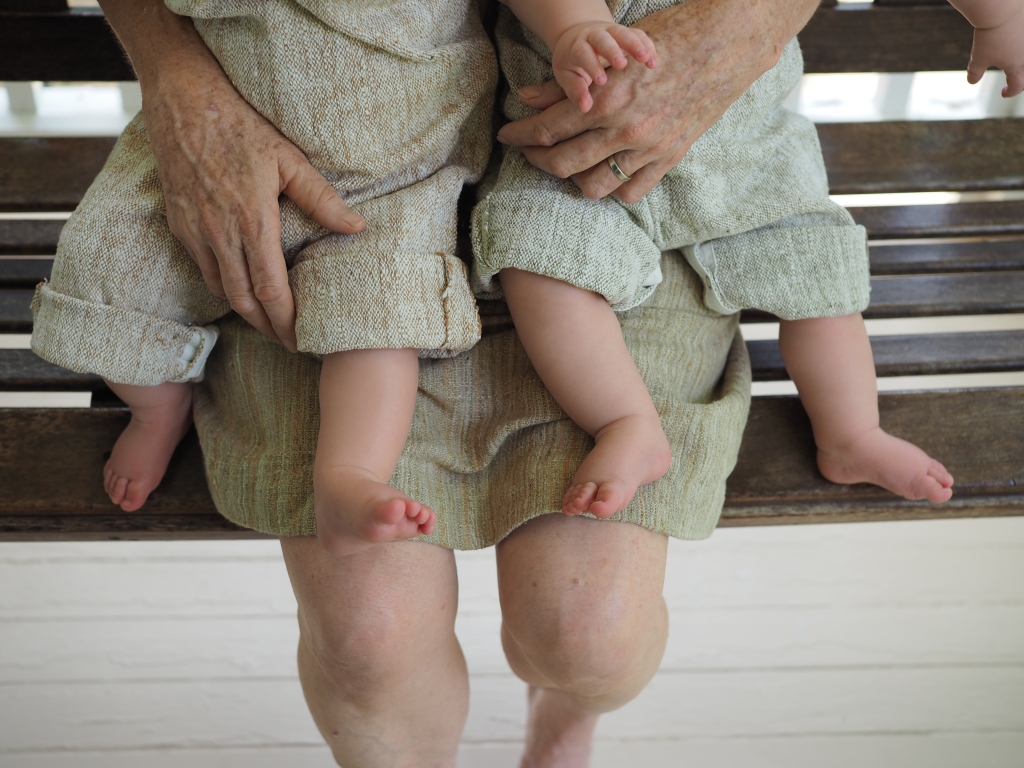
Homegrown cotton vest with black walnut-dyed shirt.
Fibershed is the name of a non-profit organization started by Rebecca Burgess in 2010 in California. Her goal was to “develop and wear a prototype wardrobe whose dyes, fibers and labor were sourced from a region no larger than 150 miles from the project’s headquarters.” Since then her work has expanded and other Fibershed groups around the world have signed on to explore textile production in their own regions. You will find their Facebook pages and activities on the Internet. It is a fitting name for a group looking close to home for their fiber sources. Just like watershed is concerned with where the water comes from for a region, and foodshed looks at our local food systems, I can see the word fibershed becoming a buzz word anywhere someone is talking about clothing themselves locally.
On the Fibershed website I found the term soil-to-skin. I have often used the term seed-to-garment, but I like soil-to-skin, since it takes the concerns further. I also found soil-to-soil used on the website. If your clothes will compost, just bury them at the end of their useful life and let them replenish the soil. Twenty years ago not so many people were as concerned about the source of their food as they are presently. Now, I hope they start talking more about where their fiber comes from—their fibershed. As with their food, it all starts with the soil to produce cotton, flax/linen, and wool. Synthetic fibers are not part of this conversation.

brown cotton boll
Many of the Fibershed groups deal heavily with wool. That could be because there are more farmers with small herds of fiber animals than there are farmers with small plots of cotton. I don’t say much about wool because I have my hands full with the cotton and flax/linen from my garden. So much of the cotton grown worldwide is genetically modified that you might think that non-GMO organic cotton is not available to the consumer. I sew my own clothes and set out to see what I could find. It would be wonderful to have sewn a whole wardrobe by now from my homegrown cotton and linen, but so far I have only a vest and a shirt. Spinning the fiber takes time, but it is mindful and enjoyable work. I have learned about the toxic effects of textile dyes and have been exploring those, also. There is a black walnut tree in my backyard and I eat lots of onions from my garden. Walnuts and onion skins are both terrific for dyeing.

Shirt dyed with onion skins.
I like to use Kona cotton for shirts because it wears so well. When I did some checking I found that it met the Standard 100 by OEKO-TEX certification for human-ecological requirements. That doesn’t mean it is organic, but they are moving in the right direction. You’ll find Kona cotton in fabric stores and quilt shops. I wanted to make a shirt to wear with my homegrown cotton vest, but couldn’t find a color in my fabric store that would do. However, this fall I had experimented with the black walnuts and realized that produced just the color I needed. Furthermore, I discovered that Dharma Trading Company sold Kona Cotton PFD (prepared for dyeing); meaning that it was not treated with optical whiteners. I bought enough for two shirts. You can see the black-walnut dyed shirt in the first photo at the top of this page and the shirt dyed with onion skins here. Obviously, this shirt took the color well from the onion skins. I’ve already rinsed out any extra color, but it may fade a bit over time. The buttons were in my stash from previous projects or cut from old clothes.
I needed a new turtleneck shirt to wear with my new homegrown cotton shirt. It is hard for me to find cotton turtlenecks in the weight of fabric I want (they all seem to be too thin) and ones that have cuffs and enough length in the body and in the sleeves. My search for organic cotton led me to Organic Cotton Plus, a company started in Texas by organic cotton farmers to sell directly to people like you and me. It has since entered the global marketplace. I found nice organic cotton interlock for my turtleneck shirts! You can order swatches (99 cents each) of the fabrics you are interested in if you want to see and feel it first, like me. I bought enough fabric for two shirts and made a pattern from an old turtleneck that fit me best, making adjustments as necessary. I love this new shirt. It is a recent project, so sorry, I have no photo to show you of the turtleneck I made, but you’ll see it eventually. I will make the second shirt when I decide what I want to dye it with. Organic Cotton Plus had this interlock in colors, but none that matched what I needed.
I initially took an interest in Organic Cotton Plus because I was looking for organic cotton grown in the U.S. I had already bought naturally brown denim for jeans from Sally Fox at Vreseis.com. Although that’s how it started out, not all the cotton for fabrics sold through Organic Cotton Plus comes from this country. I see that the organic fabric for my turtlenecks came from India. Maybe I’m helping to support the Indian farmers that Vandana Shiva worked with to overcome their experience with Monsanto and GMOs. That would be a good thing.

I knitted three pairs of wool socks this past year from yarn I bought from Kathy Oliver of Sweet Tree Hill Farm. Kathy is a shepherd and we are both members of the same handspinning group. I bought the first two skeins at the Powhatan Fiber Festival in April and knitted the first pair in the natural color. I grew Japanese indigo last summer and used it for my first dyeing adventures, resulting in the blue socks. It was so much fun I bought a third skein when I saw her at the Fall Fiber Festival in October. I used that skein to play with indigo, onion skins, and black walnuts to make variegated yarn.
I applaud the groups that are working to develop textile systems that are environmentally safe and people friendly. It is when we take a closer look at our systems that we can detect ways we can change them—or, maybe do without. You probably know that I’ve worked with growing food and looking closely at what it would take to grow a complete diet. In my blog posts on Homegrown Fridays I share my experiences of limiting what I consumed on the Fridays in Lent to only what I grew myself. That was definitely an eye-opener, so I can see that if someone decided to limit their clothes to what could be produced naturally in their region, they have an adventure ahead of them. Rebecca and her group are working to change the system. I am on a personal journey to produce my own clothes as close to home as possible. If I have to buy fabric or yarn I want my purchases to do the most good they can. Meanwhile, I hope that by sharing my experiences, others will start a journey of their own. There is so much fun stuff to do in this world on our way to making it a better place!
Read Full Post »












